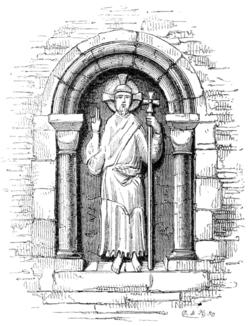the Committee a rubbing, taken from a sepulchral brass, which exists in the south aisle of the nave of Glasgow cathedral, and is the only example of that kind of memorial hitherto noticed in Scotland. It consists of an oblong plate, measuring three feet by two, formed of mixed metal of darker colour, and harder quality, than was usually employed for monumental brasses; a moiety of the plate is occupied by the following inscription:—HEIR • AR • BVREIT • Sr • WALTIR • Sr • THOMAS • Sr • IHONE • Sr • ROBERT • Sr • IHONE • AND • Sr • MATHIEV • BY • LINEAL • DESCENT • TO • VTHERIS • BARONS • AND • KNIGHIS • (sic) OF • THE • HOVS • OF • MYNTO • WT • THAIR • VYFFIS • BAIRNIS • AND • BRETHEREIN. On the Other half of the plate appears a single kneeling figure, in armour, and above, the word Jehovah, in Hebrew characters, from which descend rays of glory. The date 1605 is inscribed on the stone to which this plate is attached.
March 12.
The Rev. George S. Munn, of Cradley, Herefordshire, communicated a drawing of a remarkable specimen of early sculpture, which exists at Leigh church, near Worcester.
It is a figure of the Saviour, which measures in height 4 feet 10 inches, and appears, by the character of the design, to have been sculptured about the twelfth century. It is now placed on the exterior of the northern side of the nave, in a kind of niche, or recess, which was once apparently one of the round-headed window-cases of the original Norman church. This recess, which measures 6 feet in height, is placed at the height of 15 feet 2 inches from the ground. Mr. Munn states that another figure, of very similar character, exists at the church of Rouse Lench, near Evesham. Examples of figures of the Saviour are of rare occurrence, in consequence of the destruction of all such representations and images, at the Reformation, and subsequently by the Puritans.
Mr. Munn presented also drawings of two monuments, which are to be seen at Bredon church, Worcestershire. One of these, recently discovered, has been placed on the southern side of the chancel; it is elaborately sculptured, and of very singular design. In the lower part appears a crucifix, the shaft and limbs of the cross being ragged, or raguly; above are seen the busts of a man and his wife, placed under purfled canopies. From the head of the Saviour proceeds a dove towards these

